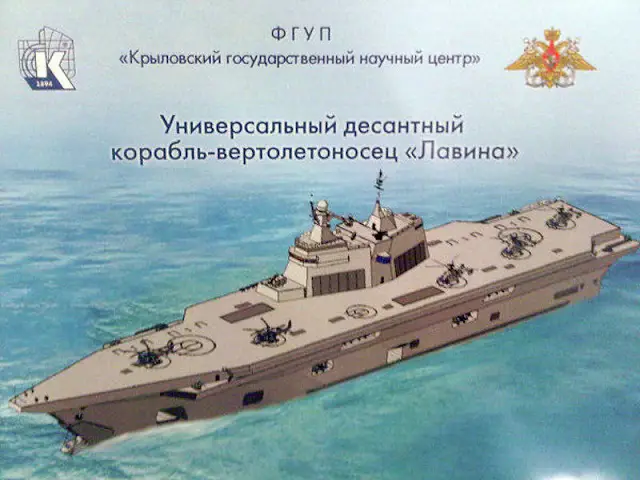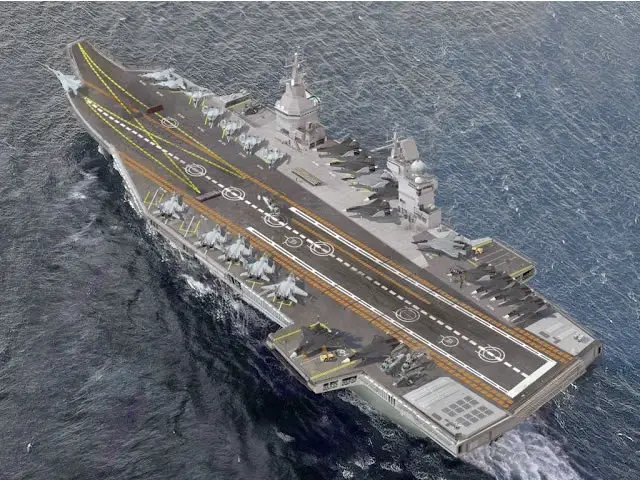Breaking news
Russia’s Future Aircraft Carrier Project 23000E Storm Will Be Nuclear-Powered According to OCK.
| 2015
 Image
showing Krylov Central Scientific Research Institute's Avalanche (Lavina)
Project with the official seal of the Russian Navy. Image
showing Krylov Central Scientific Research Institute's Avalanche (Lavina)
Project with the official seal of the Russian Navy. |
|||
Mistral
amphibious assault ship replacement A spokesman for the United Shipbuilding Corporation said Russia’s shipbuilding industry has not yet received from the Navy the terms of reference for a new generation amphibious assault ship. "The industry has no terms of reference at this point," the source said, adding that it would be a dramatically new ship. The United Shipbuilding Corporation is undergoing fundamental technical upgrade. When completed, it will enable the USC to build advanced ships for the Russian Navy," the source told TASS. Earlier, the Russian Navy’s commander, Admiral Viktor Chirkov, mentioned plans for designing large amphibious assault ships of the future capable of carrying a dozen helicopters and 450 Marines. The Defense Ministry said the first new generation amphibious assault ship will be delivered by 2020. The ship’s displacement is estimated at 16,000 tonnes. The Navy’s officials said the image of the ship had been formed, while the USC remarked that the plans had not gone any farther than preliminary sketch design. The shipbuilders said that Russia’s future amphibious assault ships were in the project concept phase. Each such ship will take less than five years to design and build. At the international naval show in St. Petersburg in July Admiral Chirkov told the media that the yet-to-be-created ship would carry 16 helicopters, an attack force of 450 men and 80 armoured vehicles. It remained unclear whether the concept had anything to do with the amphibious assault ships that are being developed. During the ARMY-2015 defense exhibiton in June, a new project called "Avalanche" was unveiled: Krylov State Research Center developed the Avalanche project of amphibious assault ship as a replacement for the cancelation for the Mistral class deal with France. |
|||
 Twelve
ships of the 10,000t "Leader class" are planned to enter service
from 2023-25, split between the Northern and Pacific Fleets. They will
all be nuclear powered. They will be fitted with the ABM-capable S-500
SAM and Kalibr (SS-N-27) cruise missile. Image for illustration purpose
only: Twelve
ships of the 10,000t "Leader class" are planned to enter service
from 2023-25, split between the Northern and Pacific Fleets. They will
all be nuclear powered. They will be fitted with the ABM-capable S-500
SAM and Kalibr (SS-N-27) cruise missile. Image for illustration purpose
only:Severnoye Design Bureau Project 21956 class destroyer. |
|||
Nuclear
power unit for aircraft carrier to be tested on Leader (Lide) class destroyer In early July, a shipbuilding industry source told TASS that the nuclear power generating facility for the propulsion system of Russia’s future aircraft carrier will be worked out on the Lider (Leader) class destroyer. The Russian Navy plans in the future to obtain new aircraft carriers, but the timeframe for the construction this class of vessel is unknown. The Navy has said that a prospective aircraft carrier will be built no earlier than in 2030. Last week Russia and France agreed to discontinue the contract for the supply of two Mistral helicopter carriers ordered for the Russian Navy in 2011. |
|||



























 A
nuclear powered Project 23000E Storm aircraft carrier may displace 80,000
to 85,000 tonnes with some 70 aircraft on board.
A
nuclear powered Project 23000E Storm aircraft carrier may displace 80,000
to 85,000 tonnes with some 70 aircraft on board.